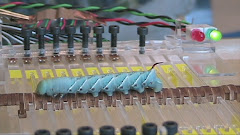 People often ask me what I do with caterpillars and poke their head toward my various apparatus. Well, this one is obvious! "Why are you dipping caterpillars into water?"
People often ask me what I do with caterpillars and poke their head toward my various apparatus. Well, this one is obvious! "Why are you dipping caterpillars into water?"Together with a hard working undergraduate research student, we perform an simple experiment what Akimidis would have appreciated very much. By dipping the caterpillar progressively, we could map the volume contribution from head to tail by quantifying the buoyancy. This simple method easily
 beats the fancy 3D laser scanning, MRI imaging, and X-ray data our predecessors attempted before us in this lab. The only special skill is to tam the caterpillars to stay still during the measurment. Well, this is what caterpillars do in nature -- "I'm not here!!" Nevertheless, cold water can be irritating, thus controling the temperature is critical. The total emersion directly gives the overal body density of any given caterpillar.
beats the fancy 3D laser scanning, MRI imaging, and X-ray data our predecessors attempted before us in this lab. The only special skill is to tam the caterpillars to stay still during the measurment. Well, this is what caterpillars do in nature -- "I'm not here!!" Nevertheless, cold water can be irritating, thus controling the temperature is critical. The total emersion directly gives the overal body density of any given caterpillar.Another collateral experiment was something Sir Issac Newton would have been quite interested. We balance a lightweight beam with the caterpillar on it by providing a pivot support below the beam. By measuring the moment force at one end, and shift the pivot across the animal, the mass distribution can be easiliy calculated. The first immediate result is the center of mass for the animal. Combining this data with the above volume map, we can reconstruct a density map across the animal body length.
Density map and mass distribution are two crucial parameters for any biomehcnaical model of a soft body. In addition, the density change across different animal sizes indirectly reflect the trachael volume and respiratory capacity, since most other tissues in the body are similar to water density. Open gas cavities also affect the use of hydrostatic skeleton for a soft-bodied animal. If some caterpillars don't use their hydrostatic skeleton for locomotion, maybe their bodies are too leaky for economic pressurization.
PS: The caterpillar in the lower photo was groomming after a water bath!!

.jpg)
Di;
ReplyDeleteI do my best to translate it. Whatever, somethings wrong, Pls revise it.
阿基米德毛蟲
人們經常問我,在各種測具上,我是怎樣馴服毛蟲投向設定的意向呢?比如說!「為什麼把毛毛蟲浸在水裡?」
我與一個勤奮工作的大學生,作了一系列連阿基米德都極為讚賞的簡單實驗:藉由浸在水裡行進中的毛蟲,通過從頭到尾量化的浮力可以映像出體積分佈,如此簡單方法所量測的數據,輕易地打敗花俏三維激光掃描、核磁共振成像、X光所蒐集的數據,這些數據是前輩們以前在實驗室努力的;這樣的設計唯一的特殊技巧是,在測量期間內,馴服毛蟲始終進行於量具上;同時,這又恰恰是毛蟲的天性 ─ 「呵!我不在這裡!」;不過,冷水會刺激蟲體,從而控制水溫是至關重要的。完全泡浸法,對於任何毛蟲,都能夠直接量出整體〈體密度〉。
另一項附屬的實驗是牛頓爵士本來頗感興趣的東西。用輕型懸杆下面的一個支點來平衡杆上面的毛毛蟲。通過測量端點力矩,並移動橫跨這動物的支點,可以容易地計算出質量分佈;第一個直接的結果為動物質量中心,與上面的體積圖結合這些質量數據,能於動物軀體上,依循長度重建一個密度圖。
對於任何軟體生物的力學模型,密度圖和質量分佈是兩個重要參數。此外,在動物不同尺寸的密度變化間接反應出氣管容量和呼吸容量,因為大多數體內其他組織與水的密度相似。使用液壓骨骼的軟體動物打開氣腔也會影響這些參數,某些毛毛蟲不使用自己的液壓骨骼來運動,也許是他們的身體太多漏洞,不利於加壓動作。
【註】下方照片:水浴後正在梳毛整妝的毛毛蟲!~~~~